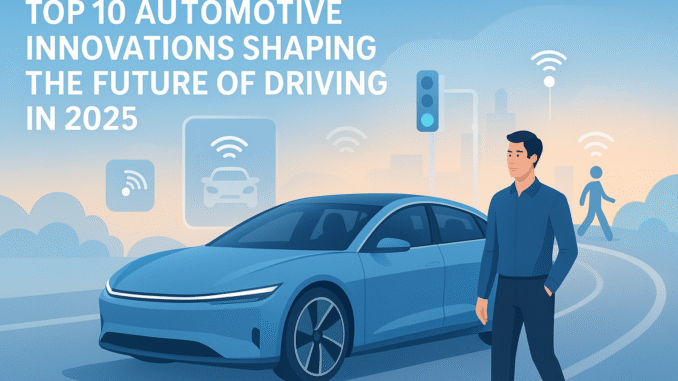
Top 10 Automotive Innovations Shaping the Future of Driving in 2025
The automotive industry is undergoing a major transformation in 2025. Driven by technological advancements, sustainability goals, and changing consumer demands, cars are no longer just vehicles—they are smart, connected, and eco-friendly mobility solutions. From electric powertrains to self-driving technology, innovations are shaping the way we drive, commute, and interact with our vehicles.
In this article, we’ll explore the top 10 automotive innovations in 2025 that are redefining the future of driving.
1. Electric Vehicles (EVs) Becoming Mainstream
Electric vehicles are no longer niche; they are becoming the new standard. Automakers around the world are investing heavily in EV production, offering more affordable models with longer ranges. By 2025, many countries are introducing policies to phase out fossil fuel-powered cars, accelerating EV adoption.
Key improvements include:
- Extended battery range: Some EVs now offer over 600 miles on a single charge.
- Faster charging: New charging stations can power up cars in under 15 minutes.
- Affordability: More budget-friendly EV models are hitting the market, making them accessible to the average driver.
EVs are not only environmentally friendly but also cost-effective, offering lower running and maintenance costs compared to traditional vehicles.
2. Autonomous Driving Technology
Self-driving cars are moving closer to reality in 2025. While fully autonomous vehicles are still being tested, many cars now come with Level 3 autonomy, where the vehicle can handle most driving tasks in specific conditions.
Notable features include:
- Automated lane changing and highway driving
- AI-powered adaptive cruise control
- Collision prevention with advanced sensors
Companies like Tesla, Waymo, and major automakers are leading the charge in developing reliable self-driving technology. Over the next few years, we can expect safer, smarter, and more efficient autonomous systems.
3. Vehicle-to-Everything (V2X) Communication
In 2025, cars are not just machines—they’re becoming part of a connected ecosystem. V2X technology allows vehicles to communicate with each other, traffic signals, infrastructure, and even pedestrians’ smartphones.
Benefits of V2X include:
- Reduced accidents by alerting drivers to hazards ahead.
- Improved traffic flow by syncing with smart traffic lights.
- Support for autonomous vehicles, enabling cars to share real-time data.
This innovation is critical for smart cities, where vehicles and infrastructure work hand-in-hand to create safer and more efficient transportation networks.
4. Advanced Driver Assistance Systems (ADAS)
Even before full autonomy, ADAS features are making cars safer than ever. In 2025, most new vehicles come with advanced safety technologies that were once considered luxury add-ons.
Popular ADAS features include:
- Blind-spot monitoring
- Automatic emergency braking
- Parking assistance with 360° cameras
- Lane-keeping assist
These systems not only prevent accidents but also reduce stress for drivers, making driving smoother and more enjoyable.
5. Sustainable Materials and Eco-Friendly Design
Sustainability is at the heart of automotive innovation in 2025. Automakers are increasingly turning to recyclable, lightweight, and eco-friendly materials to reduce their carbon footprint.
Some examples include:
- Biodegradable interior fabrics made from organic fibers.
- Recycled plastics and metals in car manufacturing.
- Lightweight carbon fiber composites that improve efficiency.
Eco-friendly design extends beyond manufacturing—many automakers now adopt circular economy practices, ensuring cars are easier to recycle at the end of their lifecycle.
6. Over-the-Air (OTA) Software Updates
Much like smartphones, modern cars now receive over-the-air updates. This innovation allows automakers to enhance vehicle performance, fix software bugs, and introduce new features remotely.
Benefits include:
- Enhanced security against cyber threats.
- Continuous improvements without requiring a dealership visit.
- Personalized upgrades, such as adding new driving modes or infotainment features.
OTA updates make vehicles more future-proof, extending their usefulness and value over time.
7. Hydrogen Fuel Cell Vehicles
While EVs dominate headlines, hydrogen fuel cell vehicles (FCVs) are emerging as a powerful alternative in 2025. Unlike battery-powered EVs, hydrogen cars refuel in minutes and offer long driving ranges.
Advantages of hydrogen vehicles include:
- Zero emissions (only water vapor as exhaust).
- Fast refueling, similar to traditional gasoline cars.
- Strong potential for heavy-duty vehicles like trucks and buses.
Governments and automakers are investing in hydrogen infrastructure, making it a viable complement to battery EVs.
8. Smart Infotainment and Augmented Reality Dashboards
Car interiors are transforming into digital cockpits in 2025. Advanced infotainment systems now include augmented reality (AR) dashboards, projecting navigation, safety alerts, and driving data directly onto the windshield.
Features include:
- Voice-controlled assistants (integrated with AI).
- Seamless smartphone integration.
- Personalized driver profiles that adjust seat positions, climate, and entertainment preferences.
These systems not only improve convenience but also reduce distractions, helping drivers stay focused on the road.
9. Shared Mobility and Subscription Services
Car ownership is evolving. Instead of buying cars, many people in 2025 are turning to car-sharing platforms and subscription services.
Benefits include:
- Flexibility: Use different vehicles for different needs (SUV for weekends, compact for city driving).
- Cost savings: No long-term maintenance or insurance burdens.
- Sustainability: Fewer vehicles on the road reduces congestion and emissions.
This trend is especially popular in urban areas where car ownership is less practical.
10. Advanced Safety and Health Monitoring
Modern vehicles are going beyond protecting drivers in accidents—they are actively monitoring health and well-being. In 2025, cars feature biometric sensors and AI-driven monitoring systems.
Examples include:
- Driver fatigue detection to prevent drowsy driving.
- Heart rate and stress monitoring through steering wheels and seats.
- Emergency response systems that automatically call for help in case of medical emergencies.
These innovations make driving not only safer but also healthier for everyone on the road.
Conclusion
The automotive industry in 2025 is at the forefront of innovation. From electric and hydrogen-powered cars to self-driving technology and connected ecosystems, vehicles are becoming smarter, cleaner, and safer. These top 10 automotive innovations are not just shaping the future of driving—they are reshaping our daily lives and the way we move through the world.
As automakers continue to push boundaries, drivers can look forward to a future where cars are more than just transportation—they’re an integral part of a sustainable, connected, and intelligent mobility system.

